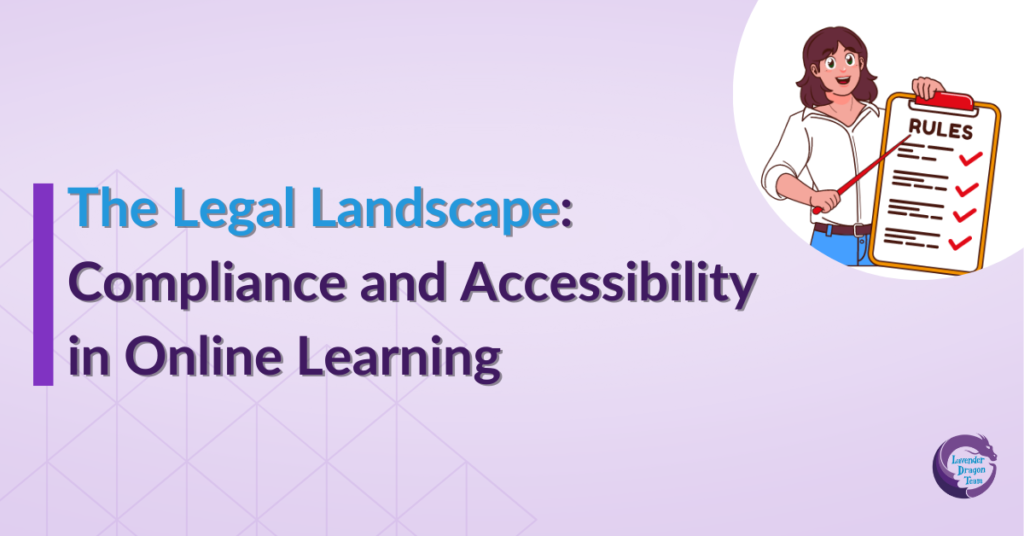Let’s talk about inclusivity! This topic is not only crucial for the success and inclusivity of your courses but also for keeping you on the right side of the law: compliance and accessibility in online learning.
Understanding the legal obligations and regulations related to accessibility can seem daunting, but it’s essential for ensuring that all learners have equal access to learning opportunities. Let’s break it down together in this comprehensive guide.

Why Accessibility Matters in Online Learning
Before we dive into the legal specifics, let’s quickly revisit why accessibility is so important:
- Ensures that all learners, regardless of disabilities, can access and benefit from learning resources.
- Accessible materials can improve comprehension and engagement for all learners.
- Avoiding legal issues and penalties by adhering to accessibility standards.
- Providing fair and equitable learning to everyone.
Now, let’s get into the nitty-gritty of the legal landscape.
Key Legal Frameworks for Accessibility
There are several key laws and regulations that govern accessibility in online learning. Understanding these frameworks is crucial for instructors and institutions to ensure compliance.
Americans with Disabilities Act (ADA)
Overview: The ADA is a civil rights law that prohibits discrimination based on disability. Title II (Public Entities) and Title III (Public Accommodations) are particularly relevant to educational institutions.
Impact on Online Learning: Requires that online learning environments be accessible to learners with disabilities. This includes accessible websites, course materials, and online platforms.
Section 504 of the Rehabilitation Act of 1973
Overview: Section 504 prohibits discrimination based on disability in programs and activities that receive federal financial assistance.
Impact on Online Learning: Educational institutions must provide accommodations and modifications to ensure that learners with disabilities have equal access to all programs and activities, including online courses.
Section 508 of the Rehabilitation Act
Overview: Section 508 requires federal agencies to make their electronic and information technology (EIT) accessible to people with disabilities.mpact on Online Learning: Although it primarily applies to federal agencies, many educational institutions adopt Section 508 standards to ensure their digital content is accessible.
Individuals with Disabilities Education Act (IDEA)
Overview: IDEA ensures services to children with disabilities throughout the nation and governs how states and public agencies provide early intervention, special education, and related services.
Impact on Online Learning: Schools must provide accessible online learning options to learners with disabilities, ensuring they receive a Free Appropriate Public Education (FAPE).
Web Content Accessibility Guidelines (WCAG)
Overview: WCAG provides a set of guidelines for making web content more accessible. While not a law, WCAG is often referenced in legal contexts.
Impact on Online Learning: Adhering to WCAG guidelines helps institutions meet their legal obligations under ADA and Section 508. The most current version, WCAG 2.1, is widely recognized.
Compliance Challenges and Solutions
Navigating the legal landscape of accessibility can be challenging. Here are some common challenges and practical solutions to help instructors, course creators, and institutions stay compliant:
Challenge: Keeping Up with Legal Changes
Regularly review updates from authoritative sources such as the Department of Education and the Department of Justice. Subscribing to accessibility and legal newsletters can also keep you informed.
Challenge: Technical Implementation
Invest in training for your IT and development teams on accessibility standards. Utilize automated accessibility testing tools like WAVE or Axe to identify and fix issues.
Challenge: Creating Accessible Content
Provide training for instructors on creating accessible content. Use accessibility checkers available in software like Microsoft Office and Adobe Acrobat to ensure documents are accessible.
Challenge: Limited Resources
Prioritize accessibility initiatives based on impact and feasibility. Collaborate with other institutions to share resources and best practices. Seek grants or funding specifically for accessibility projects.
Final Thoughts
The legal landscape of accessibility in online learning is continually evolving. As technology advances and our understanding of accessibility grows, we can expect more comprehensive regulations and standards. Staying informed and proactive is key to ensuring that your online courses remain inclusive and compliant.
Remember, accessibility is not just about meeting legal requirements—it’s about creating an equitable learning environment for all learners. By prioritizing accessibility, we can make a significant impact on the lives of learners with disabilities and contribute to a more inclusive society.
That’s a wrap on our guide to compliance and accessibility in online learning. I hope this blog has provided you with valuable insights and practical steps to ensure your courses are accessible and compliant with legal standards.

